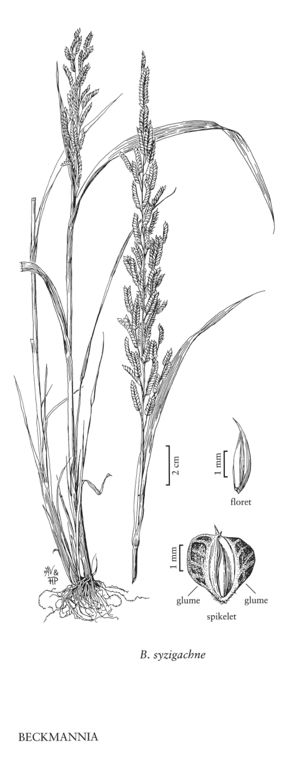Beckmannia syzigachne
Plants annual; tufted. Culms 20-120 cm. Ligules 5-11 mm, pubescent, entire or lacerate, usually folded back; blades 4-10(20) mm wide, flat, scabrous. Panicles 7-30 cm; branches spikelike, usually 1-2 cm. Spikelets 2-3 mm, round to ovate in side view, with 1 floret, a second undeveloped or well-developed floret occasionally present. Glumes appearing inflated, strongly keeled, 3-veined, apiculate; lemmas 2.4-3.5 mm, unawned, sometimes mucronate; paleas subequal to the lemmas, acute; anthers 0.5-1(1.5) mm, pale yellow. Caryopses shorter than 2 mm, light to medium brown. 2n = 14.
Distribution
Wash., Wis., Wyo., N.Mex., N.Y., Pa., Calif., Nev., Colo., Alaska, Ill., Iowa, Ariz., Idaho, N.Dak., Nebr., S.Dak., Maine, Ohio, Utah, Mo., Minn., Mich., Kans., Mont., Alta., B.C., Greenland, Nfld. and Labr. (Nfld.), Man., N.B., N.S., N.W.T., Nunavut, Ont., P.E.I., Que., Sask., Yukon, Oreg.
Discussion
Beckmannia syzigachne grows in damp habitats such as marshes, floodplains, the edges of ponds, lakes, streams, and ditches, and in standing water. It is a good forage grass, but frequently grows in easily damaged habitats.
Selected References
None.
